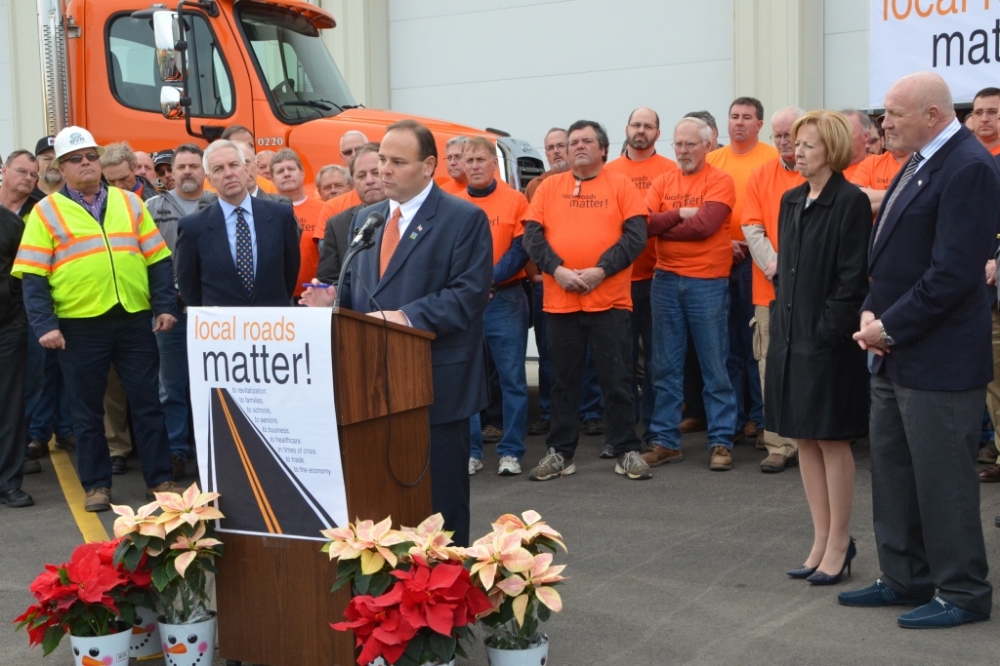Local Roads Matter: Inadequate Funding for Infrastructure Will Have Devastating Effects on New Yorkers
‘Without properly-maintained infrastructure, the very foundation of our community’s local economy is threatened.’
Assembly Minority Leader Brian M. Kolb (R,C-Canandaigua), Assemblyman Robert C. Oaks (R,C-Macedon), Assemblyman Steve Hawley (R,C,I-Batavia), Assemblyman Phil Palmesano (R,C,I-Corning), Assemblyman Peter Lawrence (R,C,I-Greece) and local leaders called on Gov. Andrew Cuomo to honor his responsibility to New Yorkers who rely on local roads and bridges to commute, do business and enjoy their neighborhoods. As the governor has pledged more than $8 billion in state funds to help close the Metropolitan Transportation Authority’s (MTA) five-year spending plan gap, local officials met to push for a similar commitment to drivers in upstate regions like the Finger Lakes.
“Upstate residents rely on locally-maintained roads and bridges to do everything from taking their children to school to delivering their harvests to nearby markets,” Leader Kolb said. “Without properly-maintained infrastructure, the very foundation of our community’s local economy is threatened — not to mention the safety of those who rely on police, fire and EMS services. I urge Gov. Cuomo to take a hard look at the importance of local roads upstate and in the Finger Lakes Region.”
Comptroller Thomas DiNapoli reports the state will need roughly $89 billion over the next two decades to rectify infrastructure needs. And, while more than $6 billion each year is collected from driver fees and assessments, only $2 billion of that goes to fund capital infrastructure improvements. Nearly one-third of local bridges are deficient and 40 percent of local roads are rated “fair” or “poor” or are getting worse. One estimate from the national transportation research group TRIP indicates drivers lose approximately $2,300 each year from time lost, fuel costs, vehicle repairs and other expenses due to deteriorating roads.
“Infrastructure is often overlooked because it doesn’t always generate catchy headlines or flashy pictures, but it is simply one of the most important parts of our economy,” Assemblyman Oaks said. “Neglecting our infrastructure does a disservice to our constituents and risks undermining the growth and progress we work toward with other initiatives. To keep upstate New York competitive, we must fight for the necessary infrastructure funding.”
“Upstate New York’s roads and bridges have been neglected for too long,” Assemblyman Hawley said. “It is long past time we treat the residents outside of the five boroughs with the respect they deserve. While New York City enjoys projects to expand and grow its services, upstate is left fighting for enough scraps to do basic winter road repairs. It is an unacceptable injustice.”
“Our Assembly Minority Conference has helped lead the charge to improve New York State’s local infrastructure,” Assemblyman Palmesano said. “Our advocacy has generated an additional $125 million to repair local roads, bridges and culverts through the CHIPs program formula. We are committed to safer commutes for parents, safer school bus rides for our kids, and more reliable shipping for industry. Investing in CHIPs is an investment in local economic development and job creation, property tax and mandate relief, and more reliable emergency services. Just as the MTA is the lifeline for downstate transportation needs, CHIPs funding is the lifeline for our upstate communities to fix their local roads, bridges and culverts. This session, we are calling on the governor to implement a five-year Department of Transportation capital plan to address our local infrastructure needs.”
“Upstate New York’s failing roads and bridges cannot wait any longer to be fixed,” Assemblyman Lawrence said. “The longer communities have to wait to repair aging infrastructure, the more time-consuming and expensive the repairs become, and that expense gets passed along to the user — the local taxpayer. The governor is fond of saying that we're one state. If that is true, upstate New York needs its fair share. We need state funds to revitalize our infrastructure on par with what the MTA has been allocated in its capital plan.”
“New York State is ready and willing to spend an additional $8.3 billion for upgrades and improvements to the Metropolitan Transportation Authority. This is necessary funding and welcome news for the city,” NYSAC President Maggie Brooks, the Monroe County Executive, said. “Upstate residents deserve parity to this downstate investment, so that all New Yorkers benefit equitably. With over $2 billion in unallocated new bank settlement funds, we have an opportunity to invest in our future in a way that puts people to work today. If you look at it this way, we can’t afford not to target the bulk of these funds to transportation infrastructure projects.”
Municipalities own and maintain 87 percent of New York’s roads and 52 percent of New York’s bridges. Nearly half, 48 percent, of the vehicle miles driven in New York are on local roads.
“Local roads and bridges are extremely important to the local economy and day-to-day lives of Ontario County residents,” Ontario County Commissioner of Public Works Bill Wright said. “If we allow our infrastructure to fall too far, it will compound the expense and time commitment needed to return New York’s local roads to acceptable standards. This problem must be addressed now, otherwise we risk putting all New Yorkers at a disadvantage.”
“Based on NYSDOT’s own projections, the state needed to spend about $6.25 billion a year to bring the state and local transportation systems to a state of good repair. Unfortunately, over the past six years, the state has averaged only $3.8 billion annually or $2.45 billion less annually than needed,” NYS Association of Town Superintendents of Highways President Jeffrey Griswold said. “Over 75 percent of the state’s roads and bridges are outside the MTA region — if the MTA and DOT had parity in their five-year capital programs (as they had for almost two decades), this would be a huge stimulus to upstate’s weak economy.”

